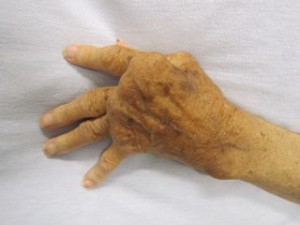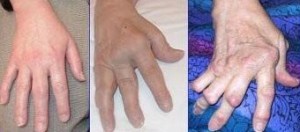Warning Signs of Rheumatoid Arthritis and Early Symptoms
Arthritis refers to any joint condition where there is inflammation. This results in joint pain, swelling, redness of the overlying skin and stiffness. But arthritis is not a single condition as many people tend to think. It is actually a group of conditions, the most common being osteoarthritis. Despite the name arthritis, osteoarthritis is not an inflammatory joint condition. It tends to affect older people and almost every person over 60 years has osteoarthritis to some extent. Next on the list is rheumatoid arthritis. It is often confused with osteoarthritis. But rheumatoid arthritis is not just a malady of the elderly. In fact it tends to start much earlier in life.
It is important to understand the differences between osteoarthritis and rheumatoid arthritis. While osteoarthritis (OA) is somewhat inevitable for every person at some point in life (usually in the senior years), rheumatoid arthritis affects only about 1% of the global population. It may seem like a small number but it is still a significantly common joint problem.
Rheumatoid arthritis is also associated with serious complications in severe cases, like deformity of the joints and disability. These complications can be minimized to some extent with early diagnosis and appropriate management. But the key is educating people to spot the warning signs and early symptoms in order to seek medical attention.
Certain people are more likely to develop rheumatoid arthritis than others. Some of the risk factors for rheumatoid arthritis are known. This does not mean that every person with one or more risk factors will develop rheumatoid arthritis. However, the chances for developing RA is higher than in people who do not have these risk factors. Not all risk factors of rheumatoid arthritis are known.
Women Around 40 Years Of Age
Rheumatoid arthritis is more common among women. It tends to start in the 35 to 50 year age group. Women are actually 3 times more likely to develop rheumatoid arthritis than men around the age of 40 years. The likelihood is somewhat equal among genders later in life.The risk in women increases significantly with certain pregnancy issues as discussed below. Therefore persistent joint symptoms in a woman around the age of 40, irrespective of how mild it may be, should be investigated further with rheumatoid arthritis in mind.
Pregnancy Problems Increases Risk
A recent study has also found an association between rheumatoid arthritis risk and pregnancy, even if it was earlier in life. Women who have just 1 child in their lifetime are at a greater risk of RA than those who have 2 or 3 children. Problems during pregnancy like hyperemesis gravidarum, gestational hypertension and pre-eclampsia are also associated with a great RA risk. Therefore women who have experienced these problems, especially if they have a first-degree relative with rheumatoid arthritis, need to be particularly cautious. Read more on rheumatoid arthritis epidemiology.
A Family Member With RA
The exact cause of rheumatoid arthritis is not known although the mechanism of the disease is understood. Genetic factors appear to play a major role. It is now known that having a first-degree relative with rheumatoid arthritis can increase a person’s risk of developing rheumatoid arthritis by two- to three-fold. A first-degree relative includes parents, siblings and children. However, genes are only a a single factor. Among monozygotic twins (identical twins) the condition only affects both twins in about 20% of cases. Therefore non-genetic factors are equally important.
Psoriasis Link With Arthritis
Psoriatic arthritis is an inflammatory joint condition that is linked with the skin disease psoriasis and closely resembles rheumatoid arthritis. This type of arthritis affects between 10% to 30% of psoriasis patients. There are many similarities between psoriasis and rheumatoid arthritis. Both are a consequence of the immune system attacking healthy tissue – skin in the case of psoriasis and the joint lining (synovium) in rheumatoid arthritis. However, psoriatic arthritis usually does not have as severe complications as rheumatoid arthritis.
Periodontitis Bacteria And RA
It has been postulated for quite a while that an infectious agent may play a role in the development of rheumatoid arthritis. This does not mean that an infection is the cause of rheumatoid arthritis. Rather the exposure to certain microoragnisms may serve as a trigger. It is believed that antibodies formed against certain bacteria and viruses may attach to the joint lining and direct the immune response against healthy tissue.
One such microorganism is Porphyromonas gingivalis, which is responsible for periodontitis, an infection of the gum and tissue around teeth. Large amounts of antibodies against this bacteria has been found in the joint fluid of RA patients. Recent studies continue to support this link between periodontal disease and rheumatoid arthritis.
Any Persistent or Recurrent Symptoms
The early symptoms of rheumatoid arthritis are often vague. It is not uncommon for RA patients to complain of mild flu-like symptoms like fever, fatigue and weight loss. This does not immediately point to rheumatoid arthritis as these symptoms can occur in a number of conditions. However, when these symptoms are persistent or recurrent then it should be investigated further. Unfortunately blood tests for substances like rheumatoid factor are not always positive in rheumatoid arthritis. Close monitoring is therefore necessary for a clinical diagnosis of rheumatoid arthritis based on the symptoms.
Small Joints First Like Hand and Toes
The small joints of the body are usually affected first in rheumatoid arthritis. This is in contrast to osteoarthritis where the condition primarily affects the large joints like the shoulder, hip and knees. Rheumatoid arthritis also affects the large joints but this usually occurs later in the condition. The small joints that are most commonly affected in the early stages are that of the hands and feet, where the fingers and toes attach respectively. This may include stiffness, pain, redness, swelling or tenderness. Characteristic symptoms like joint nodules are usually do not occur early in the disease.
Bilateral Morning Stiffness A Key Symptom
In rheumatoid arthritis, the joints on either side of the body are simultaneously affected. This bilateral presentation is one of the distinguishing factors from osteoarthritis, especially in the early stages of the disease. Morning stiffness is another characteristic symptom of rheumatoid arthritis. The inactivity during sleep results in joint stiffness upon waking which gradually eases with movement during the course of the day. Morning stiffness may also be seen with osteoarthritis at times. However, bilateral morning stiffness especially of the small joints like the hands and finger should raise the warning bells about rheumatoid arthritis even if other symptoms like joint pain are not present.







